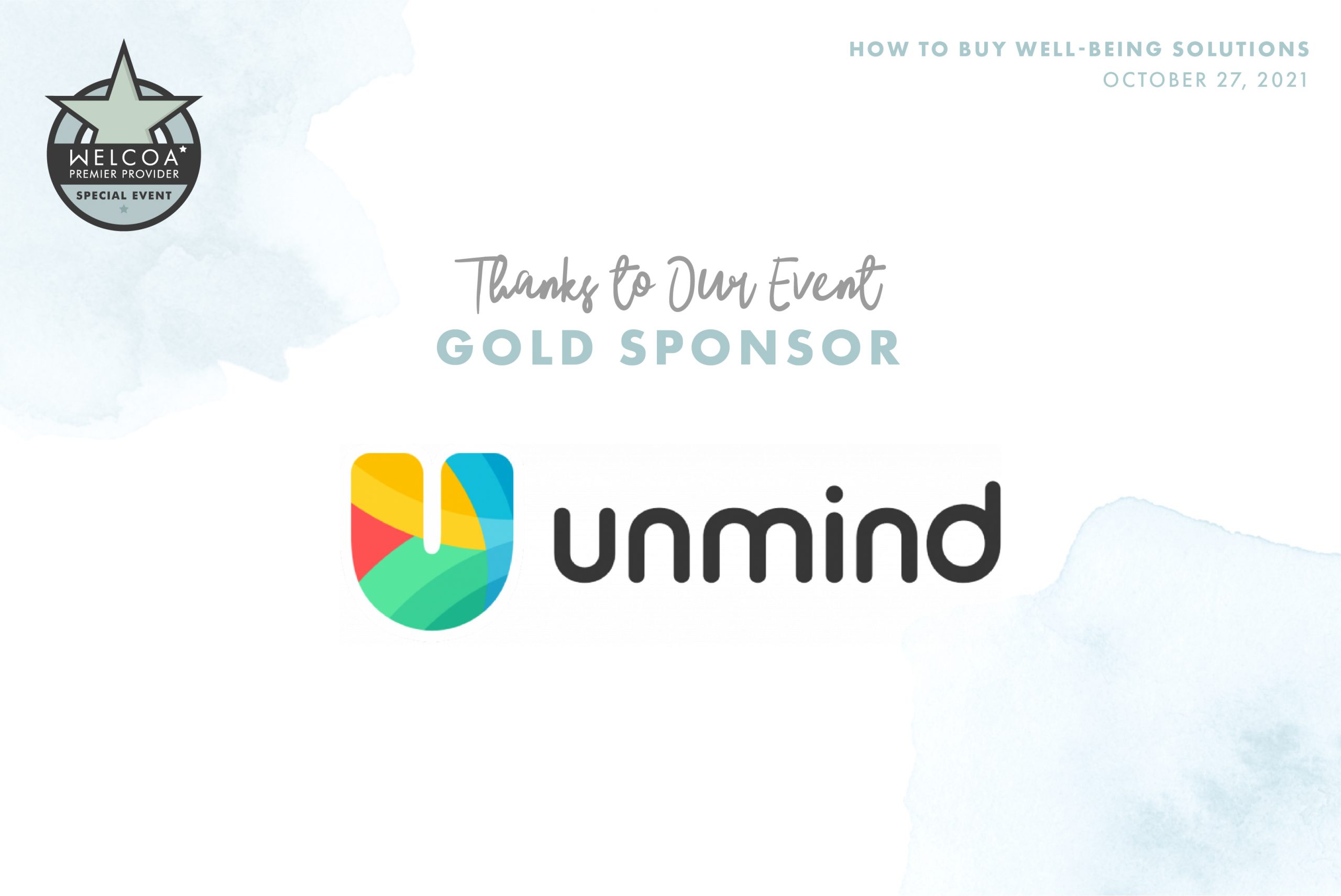During the COVID-19 pandemic, people spent a lot of time isolated and indoors, which helped foster an environment where some people now feel lonelier than ever. The result is a loss of social connectedness—the degree to which people feel the social connections and relationships in their lives to satisfy their wants and needs. When social…
Your Welcoa membership has expired.
The New Dawn of Employee Mental Health in 3 Acts
and Sara Martin, MS // CEO • WELCOA
The traditional and still typical employee mental health model focuses on reacting to specific employee needs as they arise – things like employee assistance programs (EAPs) and occupational health referrals. Rather than focusing only on those who are already experiencing challenges (roughly 1 in 5 Americans will experience mental ill-health each year), Nick designed Unmind to help companies proactively and preventatively support all of their employees. This not only improves the lives of employees, it boosts business performance by reducing the huge costs that come with absenteeism and presenteeism as a result of poor mental health. It’s a message brought home by COVID-19, which has brought employee mental health into the mainstream as a topic of conversation and taken us a step closer to gaining parity for mental and physical health and breaking the stigma for good. Whether you are an employer or a consultant helping employers make critical decisions about addressing mental health, this interview presents a clear path to removing stigma, turning the tide on anxiety and depression, and helping employers reframe employee mental well-being in the post-COVID world.
Sara Martin The numbers that surround mental health are staggering. We’ve seen the number that 1 in 5 U.S. adults will experience a mental health condition in their lives. A study from the American Heart Association found that around 75% of U.S. employees have struggled with an issue that affected their mental health. If we dig a little deeper, we see that mental illness is the single greatest cause of worker disability worldwide, responsible for over 6 in 10 missed work days. Yet what I find equally striking is that 8 out of 10 U.S. workers with a mental health condition say shame and stigma have prevented them from seeking mental health care. That’s a sad and eye-opening statistic. And if we’re honest, we all know someone – maybe even ourselves – who has suffered depression, anxiety, extreme stress, or a similar condition and told no one. Removing barriers like stigma and charting a better course requires unified messaging and support across all of the pillars that support the employee lifecycle. I’m curious what Unmind is seeing out there. What seems to be making the biggest impact and how do partners like the broker community amplify an employer’s impact?
Nick Taylor Yes, removing the stigma attached to mental illness is the first step toward having a healthier, more productive workforce – the first step toward reducing absenteeism and presenteeism, and to cutting healthcare costs. The really critical thing to focus on now is to stop talking about mental health exclusively in relation to mental ill-health. In other words, we all imagine that mental health is the absence of mental illness or, as we prefer to call it, mental ill-health. Unfortunately, this way of thinking makes mental health an either-or question. And that perpetuates the idea that mental health only needs to be talked about when people are mentally ill. Which continues to drive the stigma attached to mental ill-health and prevent people from getting support.
The second critical part of this first act – of working to eliminate the stigma around mental health – is to acknowledge the vast scale of the problem, and then see that as an opportunity. This is where brokers can play a significant role. Look at how the pandemic changed our view of employee stress, anxiety, and depression. Look at the surveys that shout out that employees in every industry and in every part of any organization want a new kind of support from their employers. They want benefits that support them so they can continue being fully productive regardless of what else is going on in their lives. But they also specifically want tools and programs that help them check in on their own mental health and support them to stay on track emotionally. Finally, and this is really critical, they want programs that provide signposts to guide them to outside help or referrals when they need it.
SM What would you tell a broker who is advising their clients on how to zero in on the right mental health partner? Is it about their cultural alignment with the organization’s goals? Is it about tech differentiators? What are the considerations from your perspective?
NT I think brokers need to advise their clients to look for vendors of mental health solutions who have this 5-in-5 point of view toward employee mental health – that every employee should be addressed and provided for. They should also advise their clients to seek a vendor with a science-backed model for delivering that support. The market is swamped with a lot of apps and programs now. Very few of them are based in solid science.
But equally important, brokers should be sure their clients partner with a vendor that has a full set of measurement tools. This really is the heart of any gold-medal workplace mental health solution. Without measurements – even a regular check of your organization’s mental health pulse from a real-time dashboard – employers don’t have what they need to drive platform engagement, see patterns, and make more informed decisions about how to fine-tune their mental health programs.
Brokers should be sure their clients partner with a vendor that has a full set of measurement tools. This really is the heart of any gold-medal workplace mental health solution.
SM That’s the big picture. I’d like to ask you more specifically about anxiety and depression. Mental Health America says depression is among America’s most costly illnesses, accounting for over $51 billion in absenteeism and productivity annually, and costing individuals over $26 billion in direct treatment costs each year. But other reports say the problem is probably worse than the numbers show. Here, too, people who need help aren’t getting it. The CDC says people who report moderate depression get help only 57% of the time. Those who report suffering from severe depression turn to professionals only 40% of the time. What is the role of employee mental health solutions in this area?
NT Again, I think it’s important to be very clear in the language we use here, when we talk about anxiety and depression. We’ve heard a lot more about these conditions since the spring of 2020, when the pandemic seemed to turn the world upside down with lockdowns, masks, and social distancing. We’ve seen all kinds of employee surveys that told us people were feeling new and even frightening levels of stress because of the uncertainty we were all facing. And all of that was true, of course.
But it’s important to note that anxiety and depression are clinically diagnosed medical illnesses. I say that because, as we reframe the discussion around mental health, work to remove the stigma around it, and show the value of proactive and preventive mental health solutions that anyone can benefit from, it’s important to remember that we will continue to need to support employees who do have diagnosed mental conditions. Today, the big ones are anxiety and depression, there’s no doubt about that.
Employers should look for workplace mental health solutions that have a very specific, science-backed path for employees who are suffering symptoms not only of anxiety and depression but any other mental condition, regardless of whether they have been diagnosed. A quality mental health solution will have strong clinical underpinnings that will include self-assessments and will “signpost” – provide clear, practical next steps for employees to take in a timely way to receive evidence-based intervention. Of course, those interventions should be based on recognized and validated models, and they may sometimes even include medication.
You see, the right workplace solution will be able to call in the cavalry, so to speak, and not rely solely on its own tools and programs to provide everything every individual needs.
As we reframe the discussion around mental health, work to remove the stigma around it, and show the value of proactive and preventive mental health solutions that anyone can benefit from, it’s important to remember that we will continue to need to support employees who do have diagnosed mental conditions.
SM That sounds like an ideal situation: Remove the stigma, provide self-assessments and mental wellness programs for everyone, and guide those with more serious or complex needs – like anxiety or depression – to the right providers and programs for further assessment and support. I assume that would also mean more people who have a serious mental health condition would continue to be engaged and productive at work and at home, right? And if that were true, that would be an even better outcome, wouldn’t it?
NT Absolutely, and really, that’s pretty much the road we believe we should all be on, whether we’re providers of workplace mental solutions, employers, or brokers. The thing to realize here is that people can have anxiety or depression, or nearly any other mental health condition, and be mentally well. They can be mentally well if you define mental wellbeing as thriving – having positive feelings and positive functioning – in their workplace performance, their interactions with colleagues, and their home life. All of that is possible regardless of any mental health condition, with the right support and tools.
What we’re saying is that employees with mental illness aren’t always struggling and don’t necessarily need to. On the other hand, the opposite is also true: Employees with no defined mental illness or condition aren’t always doing well, are they? If they were, why would so many of our high-performing, brightly shining superstars implode – or worse?
Here again, brokers can help employers make a difference. It’s about educating employers about the importance of workplace mental health solutions with robust, actionable measurement functionality. Data that delivers insights for better decision-making around employee mental health should be paramount. Also, they should look for educational and supportive tools and techniques that people can use in the moment – clinically backed techniques that are broken down into bite-size, engaging chunks, and delivered digitally for faster accessibility than employees have ever had.
Brokers can help employers make a difference. It’s about educating employers about the importance of workplace mental health solutions with robust, actionable measurement functionality.
SM I’d like to go back to something you mentioned just a little bit ago, about how someone can have a mental condition or illness and still be mentally well or, as you said, “flourishing.” This sounds like a different way of thinking about mental health than we’ve become accustomed to, or at least different from what I’ve become accustomed to. It sounds like it’s putting more emphasis on assessing how someone is doing instead of focusing on symptoms and labels. But it also seems to support your passion for workplace mental health solutions that treat the “5 in 5,” as you said, instead of focusing so narrowly on the 1 in 5 who report having a mental health concern. This sounds like it would go even further to reduce the stigma around mental health and bring a different kind of awareness to conditions like anxiety and depression. Can you expand on this concept?
NT You’re right, Sara. To us, it’s really reframing the concept of mental wellbeing in the post-COVID-19 world. It really is that important, and it’s something that brokers – and employers, of course – should know about now. Because this will help motivate and engage employees and other business leaders to understand this concept, promote it, and see how it can enhance anyone’s personal and professional life.
So, what am I referring to? As we’ve talked about, to really get everyone the support they need and also be proactive, it’s critical to establish what we mean when we talk about mental health. The critical point here is that it’s not an either-or equation, although that’s been the model since the early 1950s. And that model has actually served us very well; we’ve all established our clinical programs and workplace solutions based on it. But it has two big limitations. First, it’s not totally accurate. Second, it continues to stigmatize mental health, because it puts mental health and mental illness at opposite ends of the same spectrum – if you have mental health, then you don’t have a mental illness, and vice versa.
But now we have a model – and it’s strongly underpinned by science and about 20 years old – that is much more embracing and has a holistic or “real world” concept of mental wellbeing. Technically, it’s called the dual-spectrum model, because it has two spectrums, not just the one line that puts mental health at one end and mental illness at the other. The dual-spectrum model looks at mental health as one spectrum and mental illness as another, and it argues that we are all moving along both of those spectrums all of the time. So, rather than focus so strongly on symptoms and on labels of mental ill-health, we ask, “How is someone functioning? How are they doing? How could they be doing with the right assessments, tools, and even, maybe, treatment?” This is critical to expanding our awareness and practice of proactive, non-stigmatizing mental wellness.
But now we have a model that is much more embracing and has a holistic or “real world” concept of mental wellbeing.
SM Well, that sounds like a concept that certainly goes far beyond the traditional model of only looking for employees who need help, if that’s the best way to say that, and referring them to the EAP or to their healthcare provider. Can you give us a quick explanation of how this model could be implemented in the workplace?
NT Sure, Sara. If you think about it, it’s kind of common sense, isn’t it? This model is centered on the understanding that an employee can have a diagnosis of a mental condition and with the right programs, tools, and treatment can nonetheless be a thriving, flourishing person – at work and at home. On the other hand, an employee can have no diagnosis of a mental condition at all and be languishing – unproductive and disengaged from their coworkers and family.
The dual-spectrum model truly supports the need to view mental wellbeing as something that can be nurtured – that can be supported and treated proactively, the same way we do for our physical health. This is a very liberating, very embracing view of the whole person, and it’s very exciting. Because this model – and as I said, it’s based in solid science and has been developed over the last two decades – says that wherever you are with your mental wellbeing, there’s something you could be doing proactively to make your life more fulfilling and purposeful, more engaging, and simply feel better about your life.
But for me, the wonderful thing about all of this is that it says mental wellbeing and mental health isn’t some dreary, scary, black-and-white topic. Mental wellbeing is a beautiful, multi-colored thing with many ranges and hues, and it’s something we can constantly be cultivating and nurturing. That’s the reframing of employee mental health solutions that brokers can really help us put out there.
Mental wellbeing is a beautiful, multi-colored thing with many ranges and hues, and it’s something we can constantly be cultivating and nurturing.
SM That’s a great note to end on, Nick. Thanks so much for your time. It’s been wonderful to have this conversation with you.

Nick Taylor, Ph.D.
CEO & Co-Founder • Unmind
Nick is the CEO and co-founder of Unmind, the authoritative, trusted workplace mental health platform designed to empower employees to proactively measure, understand, and improve their wellbeing.Throughout his career, Nick has always worked in mental health. During his time as a lead clinical psychologist in Britain’s National Health Service, he realized the true importance of giving people the right care at the right time, and why the focus on mental health needs to be preventative.

Sara Martin, MS
CEO • WELCOA
Sara’s purpose is helping people fulfill their highest potential in work and life through corporate health promotion. She has launched award-winning wellness programs, created new wellness products, and engineered work environments to create cultures of health across multiple industries. She has been a session and keynote speaker at a variety of community and national events including National Health Enhancement Research Organization (HERO) Conference, the Art and Science of Health Promotion Conference, and the National WELCOA Training Summit. She sits on the Johns Hopkins Mental Health in the Workplace Advisory Council and the CDC Workplace Health Resource Center Steering Committee, and has served as Ambassador for the American Association of University Women.




